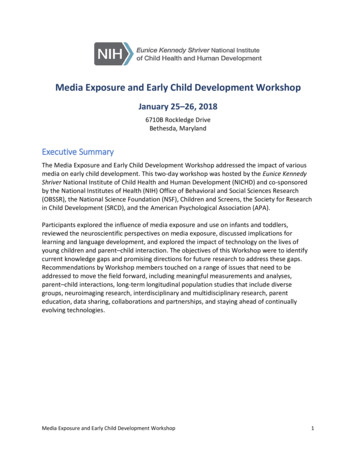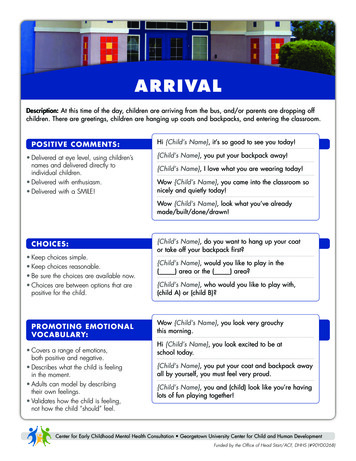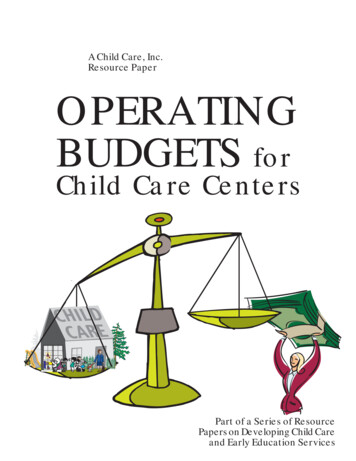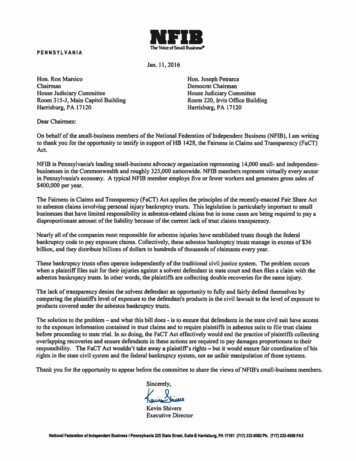
Transcription
Media Exposure and Early Child Development WorkshopJanuary 25–26, 20186710B Rockledge DriveBethesda, MarylandExecutive SummaryThe Media Exposure and Early Child Development Workshop addressed the impact of variousmedia on early child development. This two-day workshop was hosted by the Eunice KennedyShriver National Institute of Child Health and Human Development (NICHD) and co-sponsoredby the National Institutes of Health (NIH) Office of Behavioral and Social Sciences Research(OBSSR), the National Science Foundation (NSF), Children and Screens, the Society for Researchin Child Development (SRCD), and the American Psychological Association (APA).Participants explored the influence of media exposure and use on infants and toddlers,reviewed the neuroscientific perspectives on media exposure, discussed implications forlearning and language development, and explored the impact of technology on the lives ofyoung children and parent–child interaction. The objectives of this Workshop were to identifycurrent knowledge gaps and promising directions for future research to address these gaps.Recommendations by Workshop members touched on a range of issues that need to beaddressed to move the field forward, including meaningful measurements and analyses,parent–child interactions, long-term longitudinal population studies that include diversegroups, neuroimaging research, interdisciplinary and multidisciplinary research, parenteducation, data sharing, collaborations and partnerships, and staying ahead of continuallyevolving technologies.Media Exposure and Early Child Development Workshop1
ContentsExecutive Summary. 1Contents. 2Participants . 3Thursday, January 25, 2018 . 5Opening Remarks and Introductions . 5Session I: Media Exposure and Early Childhood: An Overview . 5Children’s Technology Use and Health: A Population Studies Perspective/Discussant. 5A Brief Historical Tour of Research on Media and Children’s Development/Discussant. 7General Discussion. 8Session II: Influence of Media Exposure and Use on Infants and Toddlers. 10Learning from Media in Young Children: Constraints and Opportunities/Discussant . 10A Pediatric Perspective on the Impact of Early Media Exposure/Discussant. 11General Discussion. 13Session III: Neuroscientific Perspectives on Media Exposure and Use in Early Childhood . 14Media Effects on Young Children: An Attention Development Perspective/Discussant . 14Language Development in the Digital Age/Discussant. 16General Discussion. 17Session IV: Media Exposure and Use in Early Childhood: Implications for Learning . 18Links Between Media Exposure and Language and Literacy Development/Discussant . 18Understanding Children’s Learning in Digital Contexts/Discussant . 20General Discussion. 21Final Presentation of the Day . 22Identification of Gaps in Our Research Knowledge (group session) . 23Friday, January 26, 2018 . 25Welcoming Remarks . 25Session V: The Role of Technology in Early Childhood Interventions . 25The Positive Impact of Digital Technologies in the Lives of Young Children/Discussant . 25Educational Media Exposure and Parent-Child Interactivity/Discussant . 27General Discussion. 28Future Research Directions (group session) . 29General Discussion .31Adjournment. 33Media Exposure and Early Child Development Workshop2
ParticipantsOrganizersRuben Alvarez, Ed.D., Health Scientist Administrator, Child Development and Behavior Branch,NICHDDara Blachman-Demner, Ph.D., Health Scientist Administrator, OBSSRLisa Freund, Ph.D., Chief, Child Development and Behavior Branch, NICHDJames A. Griffin, Ph.D., Deputy Chief, Child Development and Behavior Branch, NICHDFederal SponsorsEunice Kennedy Shriver National Institute of Child Health and Human Development (NICHD)National Institutes of Health (NIH) Office of Behavioral and Social Sciences Research (OBSSR)National Science Foundation (NSF)Non-Federal SponsorsChildren and Screens: Institute of Digital Media and Child DevelopmentSociety for Research in Child Development (SRCD)American Psychological Association (APA)Presenters and DiscussantsRachel Barr, Ph.D., Professor, Georgetown UniversityMartha Ann Bell, Ph.D., Professor of Psychology, Virginia TechSandra Calvert, Ph.D., Professor, Georgetown UniversityLauren Fasig Caldwell, Ph.D., J.D., Director, Children, Youth, and Families Office, AmericanPsychological AssociationPaula Fomby, Ph.D., Associate Director, Population Studies Center, University of MichiganArthur Graesser, Ph.D., Professor, University of MemphisPamela Hurst-Della Pietra, D.O., Founder and President, Children and Screens: Institute ofDigital Media and Child DevelopmentHeather Kirkorian, Ph.D., Associate Professor, University of Wisconsin–MadisonDanielle McNamara, Ph.D., Professor, Arizona State UniversityDeborah Nichols, Ph.D., Associate Professor, Purdue UniversityLaura Namy, Ph.D., Executive Director, Society for Research in Child DevelopmentNicole Patton Terry, Ph.D., Associate Professor and Executive Director, Georgia State UniversityJenny Radesky, M.D., Associate Professor, Pediatric Behavioral Clinic, University of MichiganJohn Richards, Ph.D., Professor, University of South CarolinaSarah Roseberry Lytle, Ph.D., Director, Outreach and Education Division, University ofWashingtonLesli Rotenberg, Senior Vice President and General Manager, Public Broadcasting Service (PBS)Linda Smith, Ph.D., Professor, Indiana UniversityMedia Exposure and Early Child Development Workshop3
Presenters and Discussants (continued)Suzy Tomopoulos, M.D., Assistant Professor, New York University School of Medicine andBellevue Hospital CenterGeorgene Troseth, Ph.D., Associate Professor, Vanderbilt UniversityMarina Umaschi Bers, Ph.D., Professor, Tufts UniversityElizabeth Vandewater, Ph.D., Associate Professor, University of Texas at AustinEllen Wartella, Ph.D., Professor, Northwestern UniversitySandra Waxman, Ph.D., Professor, Northwestern UniversityNICHDSujata Bardhan, Ph.D., Intellectual and Developmental Disabilities BranchJuanita J. Chinn, Ph.D., Statistician, Population Dynamics BranchLayla Esposito, Ph.D., Health Scientist Administrator, Child Development and Behavior BranchTuba Fehr, Ph.D., AAAS Science and Technology Policy FellowDella Hann, Ph.D., Director, Division of Extramural ResearchMJ Karimi, Ph.D., Deputy Chief, Office of Committee ManagementAlice Kau, Ph.D., Health Scientist Administrator, Intellectual and Developmental DisabilitiesBranchTracy King, M.D., M.P.H., Medical Officer, Intellectual and Developmental Disabilities BranchDanuta Krotoski, Ph.D., Health Scientist Administrator, Intellectual and DevelopmentalDisabilities BranchKaren Lee, M.D., M.P.H., Medical Officer, Child Development and Behavior BranchAnne Leong, Ph.D., Health Scientist and SRCD FellowKathy Mann Koepke, Ph.D., Health Scientist Administrator, Child Development and BehaviorBranchBrett Miller, Ph.D., Health Scientist Administrator, Child Development and Behavior BranchCatherine Spong, M.D., Deputy DirectorOBSSRWilliam Riley, Ph.D., DirectorErica Spotts, Ph.D., Health Scientist AdministratorOther ParticipantsSheila Moats, Program Officer, National Academies of Sciences, Engineering, and MedicineDavid Moore, Ph.D., Program Director, National Science FoundationDawn Moore, M.B.A., CPA, Sponsored University Affiliate, Georgetown UniversityMoira O’Brien, M.Phil., Health Scientist Administrator, National Institute on Drug AbuseMary Rooney, Ph.D., Program Officer, National Institute of Mental HealthAmy Sussman, Ph.D., Education Analyst/Program Officer, U.S. Department of EducationMedia Exposure and Early Child Development Workshop4
Thursday, January 25, 2018Opening Remarks and IntroductionsRuben Alvarez, Lisa Freund, and James A. Griffin, NICHD, andDella Hann, Director of Extramural Research, NICHDDr. Alvarez opened the workshop at 8:30 a.m., welcomed the participants, and introduced andthanked the sponsoring partners.In other opening remarks, Dr. Freund said that the purpose of the workshop is not to discusspolicy, but to look at what is known about the impact of media on early development anddetermine where to direct future research. Dr. Hann stressed the importance of the workshopfor finding ways to optimize health and development and the functioning of children andfamilies. She said that input from the participants will help to identify gap areas and clarify whatis already known, what no longer needs addressing, and what to address moving forward. Theemphasis is on research, not guidelines. She said that the question is no longer whether mediahas an effect, but rather how and when it has an effect. Multiple variables—social, individual,and biological—must come together to address these questions.Dr. Griffin reviewed the structure of the workshop and encouraged all attendees to take part inthe general discussions.Session I: Media Exposure and Early Childhood: An OverviewChildren’s Technology Use and Health: A Population Studies PerspectivePaula Fomby, University of MichiganDr. Fomby discussed opportunities for improving the current survey data infrastructure forstudying children’s media use and its consequences for development. Key points included: A population studies perspective refers to research based on data collected from observedsamples to make inferences about the distribution of attributes and behaviors within andbetween population subgroups and over time (historical or developmental). In practice, population research is based on analysis of mostly secondary data sets that arepopulation-representative and reflect multiple data collection methods. Population-level research has had an important role to play in quantifying the prevalence ofmedia exposure overall as well as in identifying disparities between population subgroups.These data can also document time trends and age-graded patterns of media use. Beyond prevalence indicators, population-level research allows us to document themagnitude of associations; describe population variation in impact of exposure on health;describe changes within individuals and in populations over time; use study designs,statistical methods, and quasi-experimental conditions to estimate causal effects; andMedia Exposure and Early Child Development Workshop5
research community use of public data to build a knowledge base that supports the publicinterest.Longitudinal data also offer the opportunity to consider pre-existing characteristics thatmight be associated with both frequent television viewing and later child outcomes.Population-representative data on children’s time use have been widely used to documenthow media use fits into children’s daily lives.The contemporary media regime is not well-characterized by the information included inolder data sources. Challenges posed by new media include:o New platforms and new applicationso Time versus content and context in shaping child outcomeso Diffusion of media use in householdso Media use as a “background” activityo Measuring salient “under-the-skin” pathways and outcomeso Media/technology developments outpace data collection/release/analysisTechnology-centered research, like the Common Sense surveys and studies conducted bythe Pew Research Center, is at the leading edge of collecting data on contemporary mediause, usually in great depth.Health-centered studies include a wealth of content on general health, diagnosedconditions, and functional impairments, but relatively little content on media use as ahealth behavior.The Panel Study of Income Dynamics (PSID) Child Development Supplement collectsextensive information on children’s media use. The Environmental Influences on ChildHealth Outcomes (ECHO) study, to date, has no content developed on children’s media useacross cohorts, but it potentially could be a resource for collecting such information.Place-centered data based on administrative data from schools and public agencies offer anovel approach for documenting variation in media use and assessing its association withchild outcomes.In conclusion, a population studies perspective offers critical insight into the implications ofmedia use for early child development, as demonstrated by prior research on conventionalmedia. No single population data source will be sufficient to address the expanding universeof research questions.DiscussantElizabeth Vandewater, University of Texas at AustinDr. Vandewater provided comments on Dr. Fomby’s presentation. Key points included: Population-level study data (U.S.-represented) are exceedingly rare; longitudinal populationstudies are even rarer. Experiments are great for determining causality but not at understanding the prevalence ofphenomena. Population data can help us see things in ways that smaller samples cannot. Large-sample studies are expensive; researchers should have access for secondary dataanalysis. Researchers can compare prevalence-of-use estimates from population data with their owndata and use that information when designing their own studies.Media Exposure and Early Child Development Workshop6
Adolescents who don’t have computers at home use smartphones as the main way toaccess the Internet.In a world of streaming and personalized advertising, what an adult sees, is not whatchildren see.The greatest need is for the development of new technologies and approaches to measuremedia use.A Brief Historical Tour of Research on Media and Children’s DevelopmentEllen Wartella, Northwestern UniversityDr. Wartella reviewed a brief history of research on media and child development. Key pointsincluded: The introduction of each new technology during the past century—film, radio, television,computers, and digital media—has brought recurring concerns about children’s use of thesenew technologies. With each new type of media, there was hope for an educational benefit, along withconcerns about crime and violence. Between 1928 and 1934, the Payne Fund supported 12 major investigations into the effectsof films on children’s sleep patterns, attitudes toward violence, delinquent behaviors, andother topics. These studies established a paradigm for studying how media contentinfluences child audiences and introduced new measurement techniques. In 1939, criticism about radio programming for children led the National Association ofBroadcasters to adopt a set of standards for all children’s programs. To avoid controversy,many radio broadcasters gradually replaced their children’s programs with adult fare. By1941, CBS had replaced almost all of its children’s shows with soap operas. From the 1950s through 2000s, a consensus emerged that television could be a powerfulinfluence on children, depending on its content. The 1972 Surgeon General’s studyconcluded that for some children, under some circumstances, some television has an effect. In the digital media era, new issues about social media use and adolescent depression, theeffects of virtual reality and augmented reality on perceptual development, and the effectsof constant technology connection on children’s well-being have arisen. In studying media effects on children, the “3 Cs” matter:o Child: Age, cognitive abilities, and personality traits may influence how the child isaffected by media experience.o Content: Violent programming influences aggressive behavior; prosocial programminginfluences prosocial behavior; and high-quality, curriculum-based educational televisioncan influence and support children’s learning.o Context: When children consume media along with their parents, opportunities forinteraction and parental mediation are related to how children are influenced byexposure. Every new technology is accompanied by a wave of both panic and excitement aboutpotential effects, as reflected in both popular press and empirical support.Media Exposure and Early Child Development Workshop7
DiscussantSandra Calvert, Georgetown UniversityDr. Calvert provided comments on Dr. Wartella’s presentation. Key points included: Mobile media use has reached 93% of households in the U.S., consistent with television.Television still “reigns supreme.” Viewing television and video content is not a passive experience. “A still body does notmean a blank mind.” The child is attending to the content, retaining information, convertinginformation to symbols, and responding to a motivational system. There is power in a “story well told.” Children have needs and desires for using media just as adults do—for gratification,entertainment, and education. The commercialization of childhood is still alive and well. The goal of most media companiesis to make money. Marketers are getting more sophisticated over time, using more personalization andtracking. As a result, children’s privacy is diminishing. Children who have strong relationships with characters (e.g., Dora the Explorer) in medialearn better. Increasingly interactive media with responsive characters can revolutionizeeducation. One major concern among parents is the lack of physical activity when children are usingmedia. Another concern is the loss of a quiet environment; the world is “noisy 24/7.” Children’s developmental needs have not shifted. There is a need to create a “media diet,”with quantity and quality that optimizes children’s development.General Discussion Studies done in today’s context may not be relevant later.Are there any data available on use of things like Facebook games before the age of 5? (Dr.Graesser)o Time diaries would be useful for that kind of information; data is collected about thetime of day and time of device. There may be questions about game use by youngchildren, but these have not been specific about Facebook use in children that young.(Dr. Fomby)o Smartphones and iPads are now being used by children age 1 year and younger. Fathers,in particular, encourage the early use of technology, thinking this will help when thechild starts school. Little is known about video game use at this age; it is usually seenamong boys with their fathers. There seems to be a gender difference. Television is stillthe prevalent form of media use time; video content remains the major form of mediaused online. (Dr. Wartella)o When looking at population data, it’s important to be clear about the different types ofmedia use (e.g., video games, social media, television). We tend to think all childrenhave all of those patterns, but studies have shown that there are subgroups of userswho use media in different ways. (Dr. Wartella)Media Exposure and Early Child Development Workshop8
Android-based sensing apps are in development and can yield fascinating data on theapps that children are actually using.o In addition to addressing content, it is important to address how the media is beingdelivered. Certain patterns of technology design can manipulate children (e.g., intomaking purchases). (Dr. Radesky)Have any studies looked at the effect of media on children with intellectual disabilities?o There are a few studies from the 1990s and early 2000s on television use and childrenwith mental health issues. but this is not the same as intellectual disability. Acompendium about the research was released in 2005.Have any studies addressed virtual reality, which is very different from television or tabletuse?o There are concerns about the effects of virtual and augmented reality programs onchildren under 12; one company has stopped developing these for young children forthis reason. Sesame Workshop has been working with companies on augmentedreality and its effects but is using caution because of concerns about the technology.o Young adults have experienced side effects like nausea or dizziness with virtual reality;the impact is much stronger than for observational media.We need real-time data on children’s use of iPads. Netflix and other companies are doingmore research than scientists are. In population studies, is there a way to look at iPad andFacebook use in the home?o The ECHO study is in the final stages of finalizing data; adding measures to an alreadylarge questionnaire might be difficult. Yet, there is a working group on mobile healthand mobile technology sensors, and ideas for passive measures that would not addsignificant time are welcome.o Long-term longitudinal population data are needed. PBS has some data about use bychildren to share.o Media use alone doesn’t mean anything; looking at the content is important.o Media Exposure and Early Child Development Workshop9
Session II: Influence of Media Exposure and Use on Infants and ToddlersLearning from Media in Young Children: Constraints and OpportunitiesRachel Barr, Georgetown UniversityDr. Barr discussed the content and context of early media exposure and how constraints onlearning due to cognitive development, such as the transfer deficit, can be exacerbated orameliorated. Key points included: Television is the most frequently used media format during early childhood. Background television is not benign and has been shown to interfere in children’s play andlearning. It has been associated with poorer parent–child interaction. In 42% of homes,television is on almost all the time. Studies of parental media use suggest missed opportunities for valuable social interactionswith children. Transfer of learning is an adaptive skill that develops gradually during childhood. The abilityto transfer information across content and context is important for day-to-day functioningand is central to memory theories. Learning from television, books, and touch screens involves transfer of learning acrosscontent and context. It is almost effortless by adulthood but is cognitively challengingduring early childhood. Young children consistently learn less from television and touch screens than from a livedemonstration, because it is difficult to understand how information from the screenrelates to the real world. Transfer deficit can be overcome by considering the 3 Cs (i.e., howthe child learns and the content and context of that learning). Transfer across dimensions (3-dimensional [3-D] to 2-dimensional [2-D], or 2-D to 3-D) ischallenging for children 1 to 3 years of age, due to cognitive flexibility limitations. There arevery similar patterns of learning from video and touch screens. Music, even if it is played in the background, is very much an active component of attention,learning, and memory retrieval during infancy. Cognitive overload happens easily. Learningfrom media is easily disrupted during infancy. Parents may mediate “looking patterns” toward television stimuli during infancy bydirecting their child’s attention to specific content during co-viewing. If this is the case, ahigher degree of parental scaffolding during television co-viewing should positively affectattention to and learning from television. Parental scaffolding is defined as elaborate verbal input; emotional support, warmth, andresponsiveness; and structured teaching. Parental scaffolding provides a warm andreceptive context in a challenging learning task and provides a set of individualized languageand joint visual attention cues to connect 2-D and 3-D information for the child. The contextof media exposure may contribute as much as program content does to any early learningfrom television. Cognitive processing of televised information during infancy is complex. Learning from 2-Dis cognitively demanding and complex. The potential for learning is predicted by a numberof different factors.Media Exposure and Early Child Development Workshop10
o Child: Repetition and language cues help. There is a transfer deficit from books,television, and touch screens.o Content: Features can be added to enhance learning. Processing differs as a function ofage.o Context: Scaffolding may be particularly important during early childhood.DiscussantHeather Kirkorian, University of Wisconsin–MadisonDr. Kirkorian provided comments on Dr. Barr’s presentation. Key points included: It’s important to think about the sources of information and the hierarchy of the differentlayers. Are children learning from a screen, a person, and/or an interaction? Are theydistracted? How are children encoding information? Some current unknowns related to children’s media use:o Whether/what children learn from screens and what is more difficult.o Whether some kinds of learning are more beneficial than others (e.g., rote learning vs.problem-solving).o Which children learn better, and for how long; whether they retain the information orwhether it disappears quickly. It’s important to consider individual differences, but this is difficult to do. There is a need to fill gaps and find shifts across age, even within narrow age ranges. A better understanding of parental scaffolding is needed to fill in gaps about where andwhen parents should intervene. We are starting to move toward more sensitive measures. There is a need to explore transactional effects (i.e., not just how children are learning buthow they experience what they learn).A Pediatric Perspective on the Impact of Early Media ExposureJenny Radesky, University of Michigan Medical SchoolDr. Radesky discussed pediatricians’ concerns about digital media and early childhood and therelevance for clinical care. Key points included: Pediatricians are child advocates. A pediatrician’s practice involves caring for the childrenwithin their family, social, and cultural environments. Media use interacts with each ofthese aspects, is entwined with health problems (e.g., sleep, obesity, mental health), andcomprises a large proportion of a child’s waking hours. Prior American Academy of Pediatrics (AAP) guidelines, which characterized media use as arisk factor, have limitations. A differential susceptibility model has addressed predecessors of media use based on fourpropositions:o Media effects depend on three types of susceptibility (dispositional, developmental, andsocial).o Three media response states (cognitive, emotional, excitatory) mediate the relationshipbetween media use and effects.Media Exposure and Early Child Development Workshop11
o The differential susceptibility variables act as predictors and moderators.o Media effects are transactional.Examples of dispositional, developmental, and social predictors of use by infants or toddlersinclude:o Infants with more fussing or crying have a higher duration of television viewing.o Infants and toddlers with regulatory problems are more likely to exceed AAP guidelinesat 2 years.o Toddlers with socio-emotional delays have higher odds for being given a mobile deviceto calm them down when upset and when a parent wants peace and quiet in the house.Parent characteristics that predict media use by a child include maternal mental distressand parent media practices. Possible mechanisms include media as a correlate of parentmental health, life stressors, role modeling, concept formation, relationship-based factors(i.e., withdrawal from parenting stress), and decreased reflective capacity about parent–child relationship.Guidelines need to address:o Actionable, family-centered guidance that acknowledges the major role(s) that mediaplays in households.o Shared media use and intentional/planned media use as a tool, which can help builddigital literacy.o Advocacy around marketing to help parents evaluate low-quality apps and content.o Attention on disparities in quality media access.Gaps in knowledge include:o Transactional, longitudinal associations between child characteristics and media use.o Parent–child interaction around media.o Identification of interventions and methods for implementing them through existingcommunity systems (e.g., schools, child care).DiscussantSandra Waxman, Northwestern UniversityDr. Waxman provided comments on the presentation by Dr. Radesky. Key points included: Babies’ and children’s access to media has far outpaced what we know about its impact, forbetter or worse. There is promise and peril
Media Exposure and Early Child Development Workshop January 25-26, 2018 6710B Rockledge Drive Bethesda, Maryland . Executive Summary . The Media Exposure and Early Child Development Workshop addressed the impact of various media on early child development. This two -day workshop was hosted by the . Eunice Kennedy Shriver










